Common refrigeration equipment decreases the temperature of a fluid to create a cool environment within which materials can be refrigerated or frozen. Shown below is an example of an outdoor walk-in refrigeration chamber. Each type of equipment in the table of content below has sections on general information, information about equipment design, usage examples, and advantages/disadvantages.
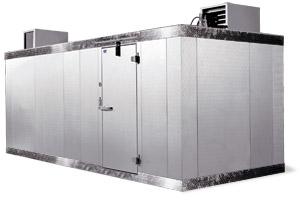
Refrigerators
General Information
Industrial refrigeration spans a temperature range of -157°C to 4°C. The more common vapor compression refrigeration uses chemicals such as CFCs (chlorofluorocarbons) and HFCs (halogenated hydrocarbons) to mechanically cool materials by expansion and compression. Absorption refrigeration, which is less common in the industry, uses mostly ammonia and lithium bromide to cool materials. Shown below is an example of an environment chamber that uses refrigeration in the stress testing of materials.
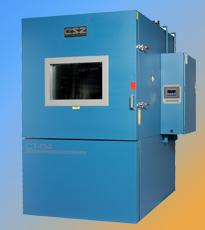
Equipment Design
All vapor compression refrigeration cycles have four major components: a compressor, a condenser, an expansion valve, and an evaporator. For larger operations, refrigeration can have more than one cycle, but the same principles and technology are always used.
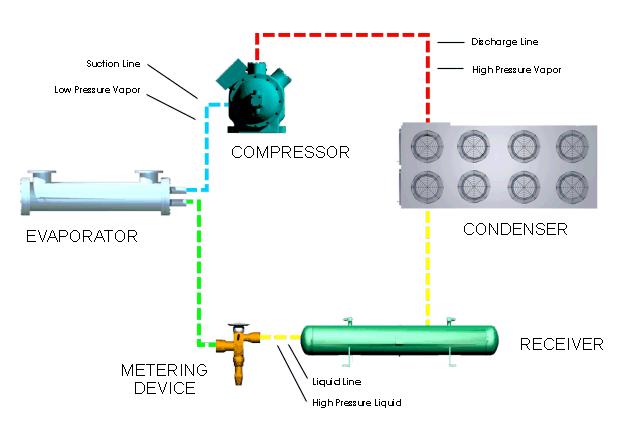
The pictures below show the individual components of the refrigeration cycle.
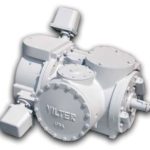



There are three main types of compressors used for vapor compression refrigeration cycles: centrifugal compressors (left), reciprocating compressors (middle), and wet rotary screw compressors (right). Compressors are explained in more depth in the Compressors section.
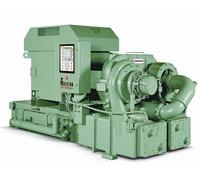
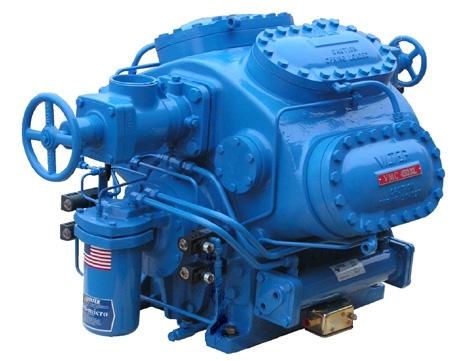
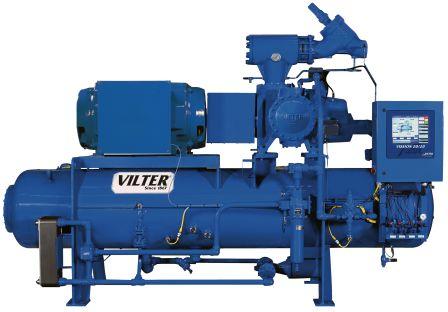
(Copyright Cameron, Houston, TX) (Pictures Copyright Emerson Climate Technologies Incorporated, Sidney, OH)
Usage Examples
The most familiar use of refrigeration is in domestic appliances, such as the household refrigerator shown below on the left. Another example of domestic refrigeration systems is air conditioning systems for houses or rooms. Refrigeration is also used in commercial systems. Examples include cafeteria and restaurant displays, as shown below on the right.
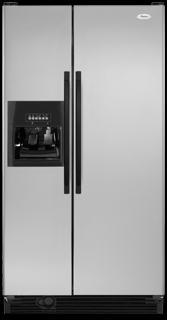
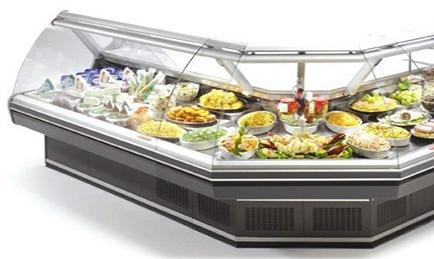
Warehouses, factories, and plants use refrigeration for cold storage and food processing. Refrigerated cabinets, chillers, or walk-in refrigeration chambers may be used.

\ (Copyright Berg Chilling Systems, Inc., Toronto, Ontario)
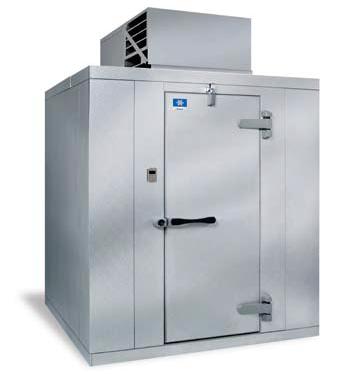
Industrial examples of refrigeration include chemical process cooling and crystallization and liquefaction of gases. Shown below is a standard refrigeration chamber used for research and development of chemicals and materials. The rapid temperature change these chambers provide allows for reduced development time as well as improved product reliability.
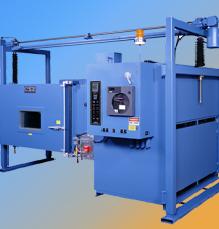
Another common use of refrigeration is in transportation. Refrigeration systems can be loaded on trucks or trailers to transport and distribute items such as food and marine containers.
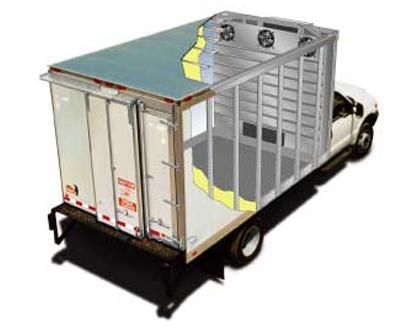
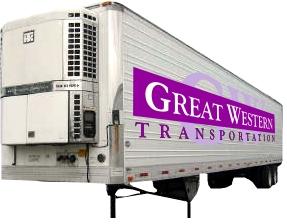
Advantages
- Wide selection of refrigeration equipment and refrigerants allows for the best possible system for any given situation.
Disadvantages
- Need for greater temperature drop usually leads to a less efficient system due to the large heat transfer.
Freezers
General Information
Freezing is the process of lowering the temperature of a product below its freezing point. Freezers share the same working principle as refrigerators. They are comprised of a compressor, condenser, evaporator, and expansion valve. The major difference between frozen and refrigerated storage is the change of state of liquid water to solid ice that may be present in a frozen product.
In the process of selecting a type of freezing equipment, there are two important factors that determine whether it would be the best option for a particular application. These include:
Feasibility of the process
This depends primarily on a product’s freezing method and whether it is being manufactured online, as it’s being produced, or offline, in a separate freezing facility. The capital and operating costs are the next items that must be taken into consideration when determining a suitable freezing plant.
Functionality
The suitability of freezing equipment for a specific product is highly important, and it depends on the size of the facility as well as the different properties of the product, such as its size, tenderness, thickness, moisture level, retention time, weight, and viscosity
Equipment Design
Freezing can occur through convective processes, such as air freezing and cryogenic freezing, or through conductive processes, including contact freezing.
Air Freezers
This method is the most common for commercial freezing. The primary advantage of this type of freezer is its large range of design configurations, including cabinet freezer, tunnel freezer, belt freezer, fluidized bed freezer, and spiral freezer. The material can be packaged or unpackaged and is frozen by exposure to chilled air at temperatures between –18 ºC and –40 ºC. The two methods of air freezing are Still Air Freezing, with slow air circulation, and Air Blast Freezing, which incorporates the use of fans to produce a strong circulation of cold air.
Cryogenic Freezers
This type of freezer, also known as evaporating liquid freezers, provides a rapid freezing rate due to the extremely low temperatures of the refrigerants used, such as liquid nitrogen and carbon dioxide. Products are generally brought through a freezing chamber via a tunnel. The refrigerant vapors pre-cool the product as it enters, and the product is then frozen as it reaches the center of the tunnel, as it is exposed briefly to liquid nitrogen. See the Cryogenic module for more information.
Contact Freezers
This type of freezer introduces a product to a freezing medium through direct contact by immersion or through indirect contact with a metal plate containing the freezing medium:
Liquid Immersion Freezer
This method involves the immersion of the packaged or unpackaged product in a cooling medium, such as in a Liquid Nitrogen Immersion Tunnel Freezer (ITF).
Plate Freezer
This method involves freezing a packaged product by contact with a metal plate that has been pre-cooled using a refrigerant. Most plate freezing techniques employ double metal plates that typically sandwich the product to be frozen under a small pneumatic pressure, increasing the contact surface between the metal plate and the package.
Usage Examples
Freezers are used in the food industry for many applications, such as to freeze dinner food trays, vegetables, meats, seafood, and poultry. Freezing is a common method of preservation, as it hinders any microbiological or chemical activity in a food product that may potentially reduce its shelf life. Airblast freezers are used for many products ranging from unpacked to packed, blocks, or Individual Quick Freezing (IQF) products, which are small individual food items such as peas and berries. Contact freezers only accept packaged products and cryogenic freezers are used only for IQF products.
Acknowledgements
- Advantage Engineering Inc., Greenwood, IN
- Arneg USA, Lexington, NC
- Cameron, Houston, TX now part of Schlumberger
- Cincinnati Sub-Zero Products, Inc., Cincinnati, OH
- Emerson Climate Technologies Incorporated, Sidney, OH
- Great Western Transportation, Pleasanton, CA
- Kidron, Washington, NC
- Manitowoc Foodservice, Parsons, TN now part of Kolpak
- Whirlpool Corporation, Benton Harbor, MI
References
- Dossat, Roy J. Principles of Refrigeration. New Jersey: Prentice Hall, 1997: 86-101. Print
- Koelet, Pieter C. Industrial Refrigeration: Principles, Design, and Applications. England: Macmillan, 1992. Print
- Langley, Billy C. Heating, Ventilating, Air Conditioning, and Refrigeration. New Jersey: Prentice Hall, 1990. Print
- Olivo, C. Thomas. Principles of Refrigeration. New York: Delmar Publishers, 1990. Print
- Perry, Robert H. and Don W. Green. Perry’s Chemical Engineers’ Handbook. 7th ed. New York: McGraw-Hill, 1998: 11-77 – 11-87. Print
- Refrigeration and Air-conditioning. New Jersey: Prentice Hall, 1998: 30-36. Print
- Ramaswamy, Hosahalli S. , and Michelle Marcotte. Food Processing: Principles and Applications. Boca Raton, CRC Press, 2006.
- Sibley, Howard W. “Refrigeration.” Encyclopedia of Chemical Technology. 4th ed. New York: John Wiley & Sons, Inc., 1993. Print
- Walas, Stanley M. Chemical Process Equipment Selection and Design. Massachusetts: Butterworth-Heinemann, 1990: 224-227. Print
Developers
- Matthew Skindzier
- Keith Minbiole
- Amani Ramli
